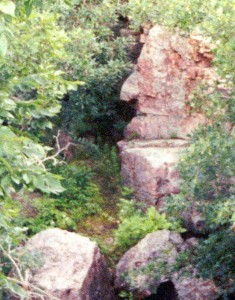The Oracle
Hidden within the rock-strewn prairie of southwestern Minnesota is an oracle. He resides in a secluded enclave, his repose disturbed only by birdsongs and the cascading of a small stream over boulders of broken quartzite.
 Beneath these boulders runs a thin seam of soft red stone, believed by some Native Americans to be the petrified blood of distant ancestors who perished in a primordial flood. So sacred is this stone that for many centuries Native Americans set aside their differences to quarry it, sharing the space with friend and foe alike. They fashioned it into the bowls of their pipes, the “holy grail” of the indigenous American. Smoke from these pipes made their words visible, carried their prayers to the Heavens in tangible form, binding them like an oath on the river Styx.
Beneath these boulders runs a thin seam of soft red stone, believed by some Native Americans to be the petrified blood of distant ancestors who perished in a primordial flood. So sacred is this stone that for many centuries Native Americans set aside their differences to quarry it, sharing the space with friend and foe alike. They fashioned it into the bowls of their pipes, the “holy grail” of the indigenous American. Smoke from these pipes made their words visible, carried their prayers to the Heavens in tangible form, binding them like an oath on the river Styx.
At the edge of this quarry is The Oracle, a stone outcropping which resembles the profile of an old man’s face, wizened by time and experience. The Oracle is among the features of Pipestone National Monument, which my wife Lori and I first visited in 1990. A guidebook explains that to the Native Americans this outcrop was believed to speak, and that medicine men traveled great distances to consult him.
When Lori and I reached the Oracle on our self-guided tour, I stepped off the path and sat beside him, placing my hand on the side of his ancient visage, feeling the unyielding stone draw warmth from my palm. I was an outsider come to this still-holy place from a world where oracles have long ago stopped speaking. But having gone this far, I set my remaining inhibitions aside and spoke in a quiet voice, greeting the outcrop in the traditional manner, calling him “Grandfather.” My head grew light and I slipped into some other, timeless world.
“Grandfather, what would you have me know?”
In a voice dry and cracked, perhaps from not having spoken for a long time, he replied:
“Grandson, do not expect to accomplish much in this lifetime, for no one shares your vision…”
Other visitors approached; I stepped away, the spell was broken. I was both incredulous and humbled at having been allowed through a barrier of the spirit — I really hadn‘t expected anything to happen. Yet at the same time I was troubled by the message. Not knowing what else to do, I returned to the Visitor Center, purchased a bag of tobacco, and left its contents on the ground next to the Oracle‘s visage.
Since that time I have more than once considered the Oracle’s pronouncement. Before then it had never occurred to me that I looked at the world any differently than anyone else, let alone that there might be enough consistency to my views to qualify them as a “vision”, an internally-coherent way of imposing order on the chaos of everyday life. Still, for whatever reason, my views of the world have never seemed to be very widespread.
But that hasn’t stopped me from offering my perspective on a variety of issues through my weekly newspaper columns, letters to editors, essays and even an occasional speech.
And while the Oracle’s words would seem to preordain that any expression of my views is doomed to accomplish little, I have in the process of my writing come closer to fulfilling the admonition of another oracle, that of Apollo at Delphi. Above the entrance to Delphi was the inscription Know Thyself. I have come to know myself better in looking back over my writing, discovering threads that connect things in ways I only half understood when I first wrote them, noticing trends to my thinking — such as the importance of place and the need to recapture the spirit of the original pioneers to revitalize rural areas — that recur in a number of guises.
I offer my vision on this website knowing full-well there are those who won’t agree with it. But while my justification for proceeding may be self-serving, I believe there is value in that which is different. The world is defined, after all, as much by differences as similarities. And while people seem to have an aversion to different opinions — a few months before writing this someone fired three shots near me in the dark, an act the local sheriff attributed to the content of my most-recent newspaper column — by examining the ways in which opinions do differ we may come to better understand not only each other but our own selves as well.